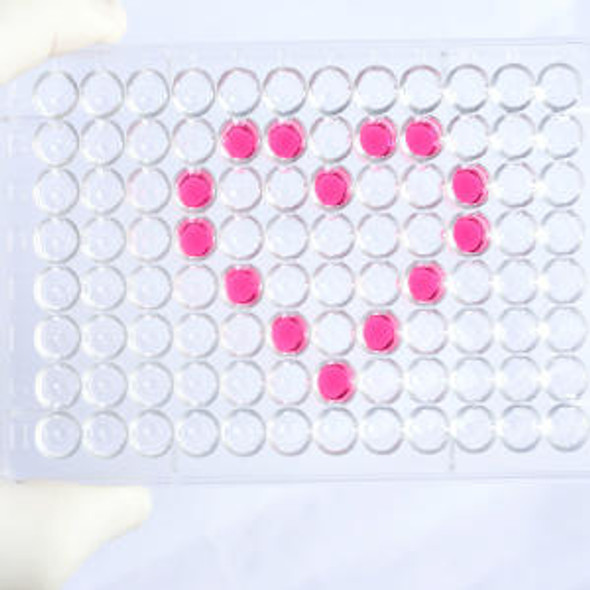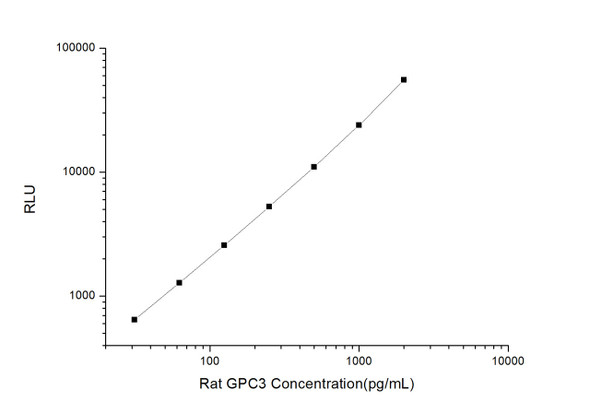Human Cell Biology ELISA Kits 5
Human GPC3 (Glypican 3) CLIA Kit (HUES00957)
- SKU:
- HUES00957
- Product Type:
- ELISA Kit
- ELISA Type:
- CLIA Kit
- Size:
- 96 Assays
- Sensitivity:
- 18.75pg/mL
- Range:
- 31.25-2000pg/mL
- ELISA Type:
- Sandwich
- Synonyms:
- DGSX, GTR2-2, MXR7, OCI-5, SDYS, SGB, SGBS, SGBS1
- Reactivity:
- Human
- Sample Type:
- Serum, plasma and other biological fluids
- Research Area:
- Cell Biology
Description
| Assay type: | Sandwich |
| Format: | 96T |
| Assay time: | 4.5h |
| Reactivity: | Human |
| Detection method: | Chemiluminescence |
| Detection range: | 31.25-2000 pg/mL |
| Sensitivity: | 18.75 pg/mL |
| Sample volume: | 100µL |
| Sample type: | Serum, plasma and other biological fluids |
| Repeatability: | CV < 15% |
| Specificity: | This kit recognizes Human GPC3 in samples. No significant cross-reactivity or interference between Human GPC3 and analogues was observed. |
This kit uses Sandwich-CLIA as the method. The micro CLIA plate provided in this kit has been pre-coated with an antibody specific to Human GPC3. Standards or samples are added to the appropriate micro CLIA plate wells and combined with the specific antibody. Then a biotinylated detection antibody specific for Human GPC3 and Avidin-Horseradish Peroxidase (HRP) conjugate are added to each micro plate well successively and incubated. Free components are washed away. The substrate solution is added to each well. Only those wells that contain Human GPC3, biotinylated detection antibody and Avidin-HRP conjugate will appear fluorescence. The Relative light unit (RLU) value is measured spectrophotometrically by the Chemiluminescence immunoassay analyzer. The RLU value is positively associated with the concentration of Human GPC3. The concentration of Human GPC3 in the samples can be calculated by comparing the RLU of the samples to the standard curve.
| UniProt Protein Function: | GPC3: Cell surface proteoglycan that bears heparan sulfate. Inhibits the dipeptidyl peptidase activity of DPP4. May be involved in the suppression/modulation of growth in the predominantly mesodermal tissues and organs. May play a role in the modulation of IGF2 interactions with its receptor and thereby modulate its function. May regulate growth and tumor predisposition. Defects in GPC3 are the cause of Simpson-Golabi-Behmel syndrome type 1 (SGBS1); also known as Simpson dysmorphia syndrome (SDYS). SGBS is a condition characterized by pre- and postnatal overgrowth (gigantism) with visceral and skeletal anomalies. Belongs to the glypican family. |
| UniProt Protein Details: | Protein type:Membrane protein, GPI anchor; Motility/polarity/chemotaxis Chromosomal Location of Human Ortholog: Xq26. 1 Cellular Component: extracellular space; proteinaceous extracellular matrix; lysosomal lumen; anchored to plasma membrane; integral to plasma membrane; Golgi lumen; plasma membrane Molecular Function:heparan sulfate proteoglycan binding; protein binding Biological Process: phototransduction, visible light; anatomical structure morphogenesis; glycosaminoglycan metabolic process; negative regulation of peptidase activity; pathogenesis; positive regulation of endocytosis; osteoclast differentiation; embryonic hindlimb morphogenesis; body morphogenesis; bone mineralization; chondroitin sulfate metabolic process; positive regulation of glucose import; glycosaminoglycan biosynthetic process; glycosaminoglycan catabolic process; ureteric bud branching; negative regulation of smoothened signaling pathway; carbohydrate metabolic process; positive regulation of protein catabolic process; positive regulation of smoothened signaling pathway; retinoid metabolic process; positive regulation of BMP signaling pathway; negative regulation of growth; anterior/posterior axis specification; negative regulation of epithelial cell proliferation; lung development Disease: Simpson-golabi-behmel Syndrome, Type 1; Wilms Tumor 1 |
| NCBI Summary: | Cell surface heparan sulfate proteoglycans are composed of a membrane-associated protein core substituted with a variable number of heparan sulfate chains. Members of the glypican-related integral membrane proteoglycan family (GRIPS) contain a core protein anchored to the cytoplasmic membrane via a glycosyl phosphatidylinositol linkage. These proteins may play a role in the control of cell division and growth regulation. The protein encoded by this gene can bind to and inhibit the dipeptidyl peptidase activity of CD26, and it can induce apoptosis in certain cell types. Deletion mutations in this gene are associated with Simpson-Golabi-Behmel syndrome, also known as Simpson dysmorphia syndrome. Alternative splicing results in multiple transcript variants. [provided by RefSeq] |
| UniProt Code: | P51654 |
| NCBI GenInfo Identifier: | 2599578 |
| NCBI Gene ID: | 2719 |
| NCBI Accession: | |
| UniProt Related Accession: | P51654,Q2L880,Q2L882,Q53H15,Q8IYG2 |
| Molecular Weight: | 65,563 Da |
| NCBI Full Name: | glypican 3 |
| NCBI Synonym Full Names: | glypican 3 |
| NCBI Official Symbol: | GPC3 |
| NCBI Official Synonym Symbols: | SGB; DGSX; MXR7; SDYS; SGBS; OCI-5; SGBS1; GTR2-2; GPC3 |
| NCBI Protein Information: | glypican-3; secreted glypican-3; glypican proteoglycan 3; intestinal protein OCI-5; heparan sulphate proteoglycan |
| UniProt Protein Name: | Glypican-3 |
| UniProt Synonym Protein Names: | GTR2-2; Intestinal protein OCI-5; MXR7 |
| Protein Family: | Glypican |
| UniProt Gene Name: | GPC3 |
| UniProt Entry Name: | GPC3_HUMAN |
As the RLU values of the standard curve may vary according to the conditions of the actual assay performance (e. g. operator, pipetting technique, washing technique or temperature effects), the operator should establish a standard curve for each test. Typical standard curve and data is provided below for reference only.
| Concentration (pg/mL) | RLU | Average | Corrected |
| 2000 | 50955 60487 | 55721 | 55693 |
| 1000 | 22737 25211 | 23974 | 23946 |
| 500 | 11763 10301 | 11032 | 11004 |
| 250 | 4905 5683 | 5294 | 5266 |
| 125 | 2648 2568 | 2608 | 2580 |
| 62.5 | 1329 1293 | 1311 | 1283 |
| 31.25 | 654 694 | 674 | 646 |
| 0 | 27 29 | 28 | -- |
Precision
Intra-assay Precision (Precision within an assay): 3 samples with low, mid range and high level Human GPC3 were tested 20 times on one plate, respectively.
Inter-assay Precision (Precision between assays): 3 samples with low, mid range and high level Human GPC3 were tested on 3 different plates, 20 replicates in each plate.
| Intra-assay Precision | Inter-assay Precision | |||||
| Sample | 1 | 2 | 3 | 1 | 2 | 3 |
| n | 20 | 20 | 20 | 20 | 20 | 20 |
| Mean (pg/mL) | 109.97 | 275.43 | 862.58 | 111.40 | 250.53 | 948.60 |
| Standard deviation | 13.86 | 23.93 | 63.31 | 11.53 | 27.83 | 108.52 |
| C V (%) | 12.60 | 8.69 | 7.34 | 10.35 | 11.11 | 11.44 |
Recovery
The recovery of Human GPC3 spiked at three different levels in samples throughout the range of the assay was evaluated in various matrices.
| Sample Type | Range (%) | Average Recovery (%) |
| Serum (n=5) | 100-114 | 107 |
| EDTA plasma (n=5) | 90-101 | 95 |
| Cell culture media (n=5) | 100-112 | 105 |
Linearity
Samples were spiked with high concentrations of Human GPC3 and diluted with Reference Standard & Sample Diluent to produce samples with values within the range of the assay.
| Serum (n=5) | EDTA plasma (n=5) | Cell culture media (n=5) | ||
| 1:2 | Range (%) | 84-97 | 94-110 | 95-112 |
| Average (%) | 91 | 100 | 103 | |
| 1:4 | Range (%) | 92-107 | 92-105 | 85-97 |
| Average (%) | 98 | 98 | 91 | |
| 1:8 | Range (%) | 88-101 | 91-103 | 89-105 |
| Average (%) | 94 | 98 | 96 | |
| 1:16 | Range (%) | 88-102 | 100-117 | 86-101 |
| Average (%) | 94 | 107 | 93 |
An unopened kit can be stored at 4°C for 1 month. If the kit is not used within 1 month, store the items separately according to the following conditions once the kit is received.
| Item | Specifications | Storage |
| Micro CLIA Plate(Dismountable) | 8 wells ×12 strips | -20°C, 6 months |
| Reference Standard | 2 vials | |
| Concentrated Biotinylated Detection Ab (100×) | 1 vial, 120 µL | |
| Concentrated HRP Conjugate (100×) | 1 vial, 120 µL | -20°C(shading light), 6 months |
| Reference Standard & Sample Diluent | 1 vial, 20 mL | 4°C, 6 months |
| Biotinylated Detection Ab Diluent | 1 vial, 14 mL | |
| HRP Conjugate Diluent | 1 vial, 14 mL | |
| Concentrated Wash Buffer (25×) | 1 vial, 30 mL | |
| Substrate Reagent A | 1 vial, 5 mL | 4°C (shading light) |
| Substrate Reagent B | 1 vial, 5 mL | 4°C (shading light) |
| Plate Sealer | 5 pieces | |
| Product Description | 1 copy | |
| Certificate of Analysis | 1 copy |
- Set standard, test sample and control (zero) wells on the pre-coated plate and record theirpositions. It is recommended to measure each standard and sample in duplicate. Note: addall solutions to the bottom of the plate wells while avoiding contact with the well walls. Ensuresolutions do not foam when adding to the wells.
- Aliquot 100 µL of standard solutions into the standard wells.
- Add 100 µL of Sample / Standard dilution buffer into the control (zero) well.
- Add 100 µL of properly diluted sample (serum, plasma, tissue homogenates and otherbiological fluids. ) into test sample wells.
- Cover the plate with the sealer provided in the kit and incubate for 90 min at 37 °C.
- Aspirate the liquid from each well, do not wash. Immediately add 100 µL of BiotinylatedDetection Ab working solution to each well. Cover the plate with a plate seal and gently mix. Incubate for 1 hour at 37 °C.
- Aspirate or decant the solution from the plate and add 350 µL of wash buffer to each welland incubate for 1-2 minutes at room temperature. Aspirate the solution from each well andclap the plate on absorbent filter paper to dry. Repeat this process 3 times. Note: a microplatewasher can be used in this step and other wash steps.
- Add 100 µL of HRP Conjugate working solution to each well. Cover with a plate seal andincubate for 30 min at 37 °C.
- Aspirate or decant the solution from each well. Repeat the wash process for five times asconducted in step 7.
- Add 100 µL of Substrate mixture solution to each well. Cover with a new plate seal andincubate for no more than 5 min at 37 °C. Protect the plate from light.
- Determine the RLU value of each well immediately.






